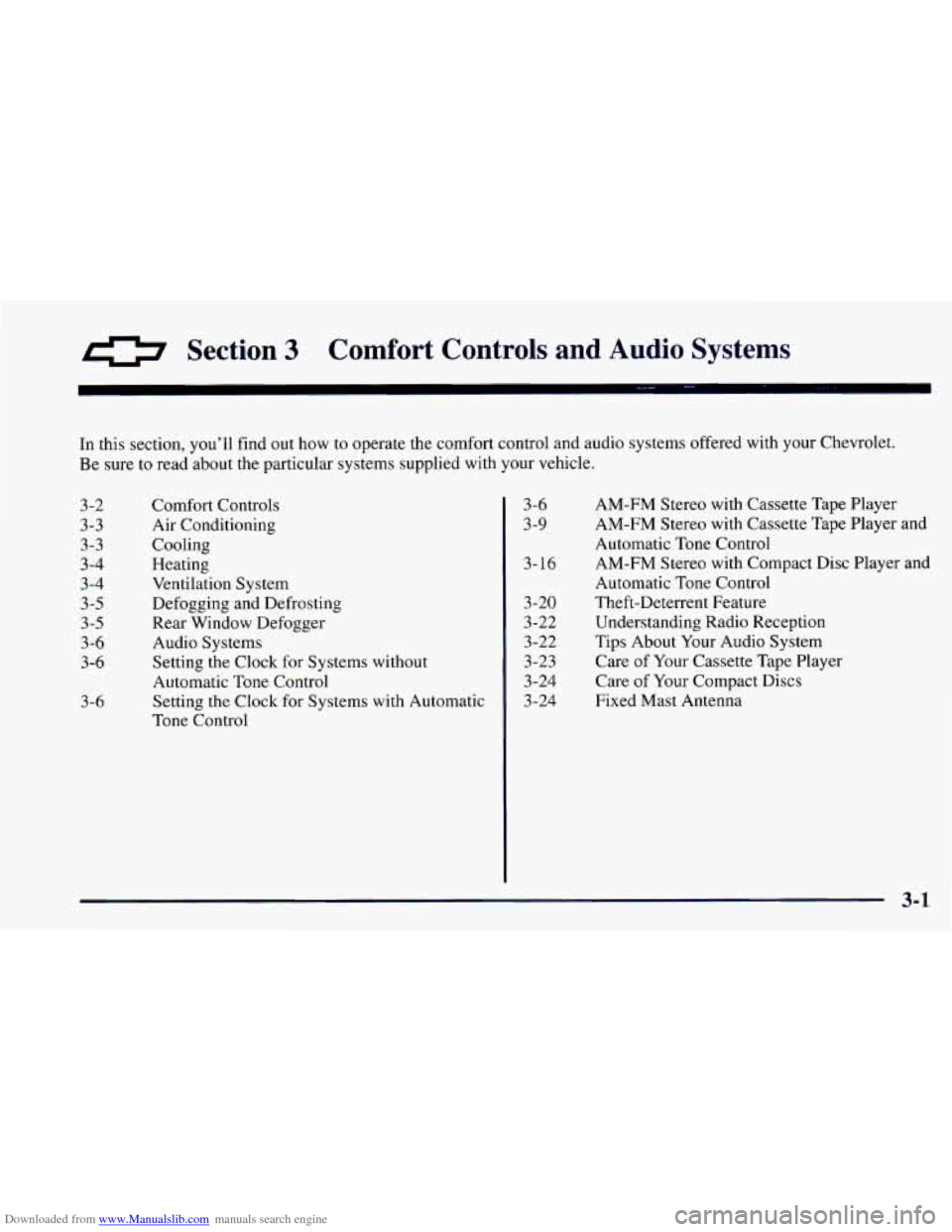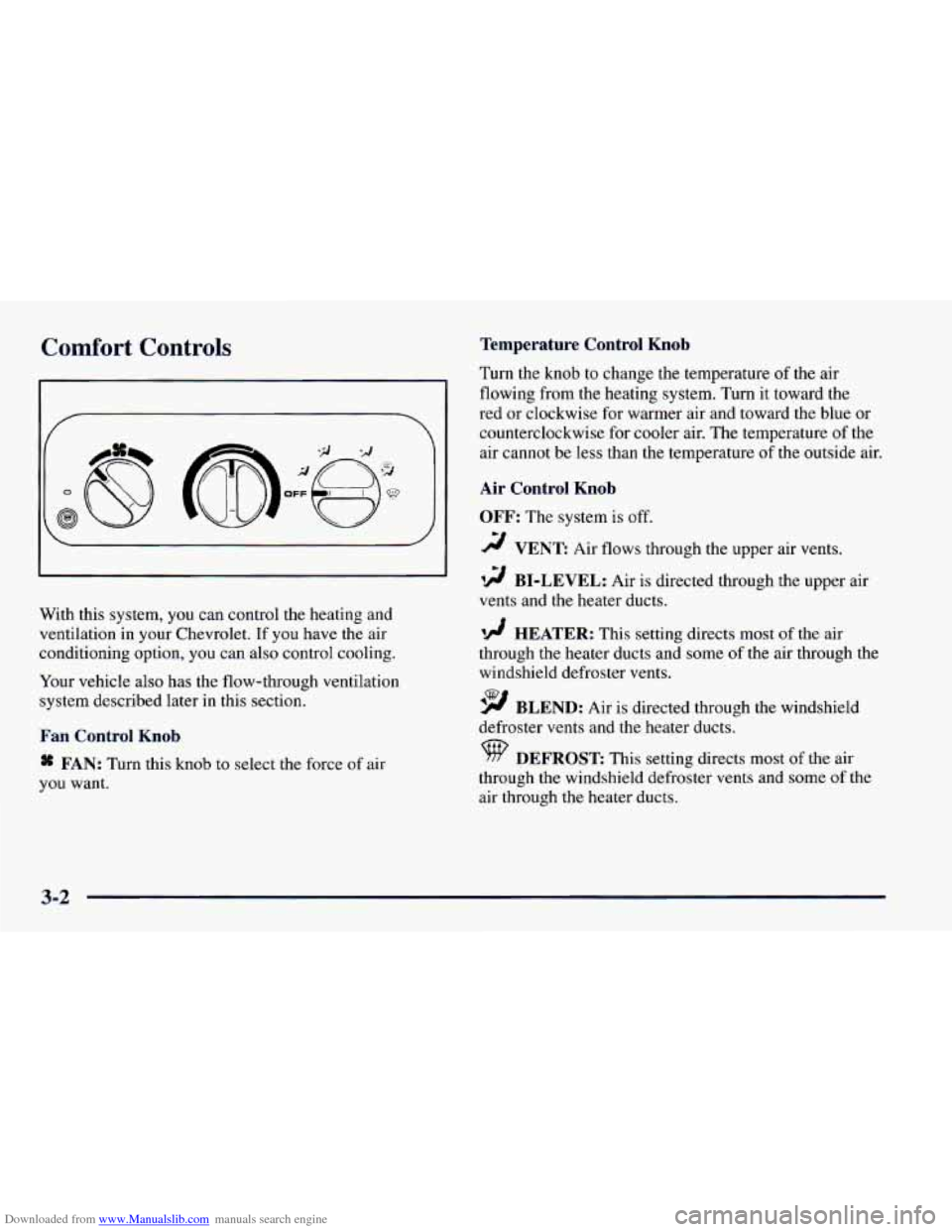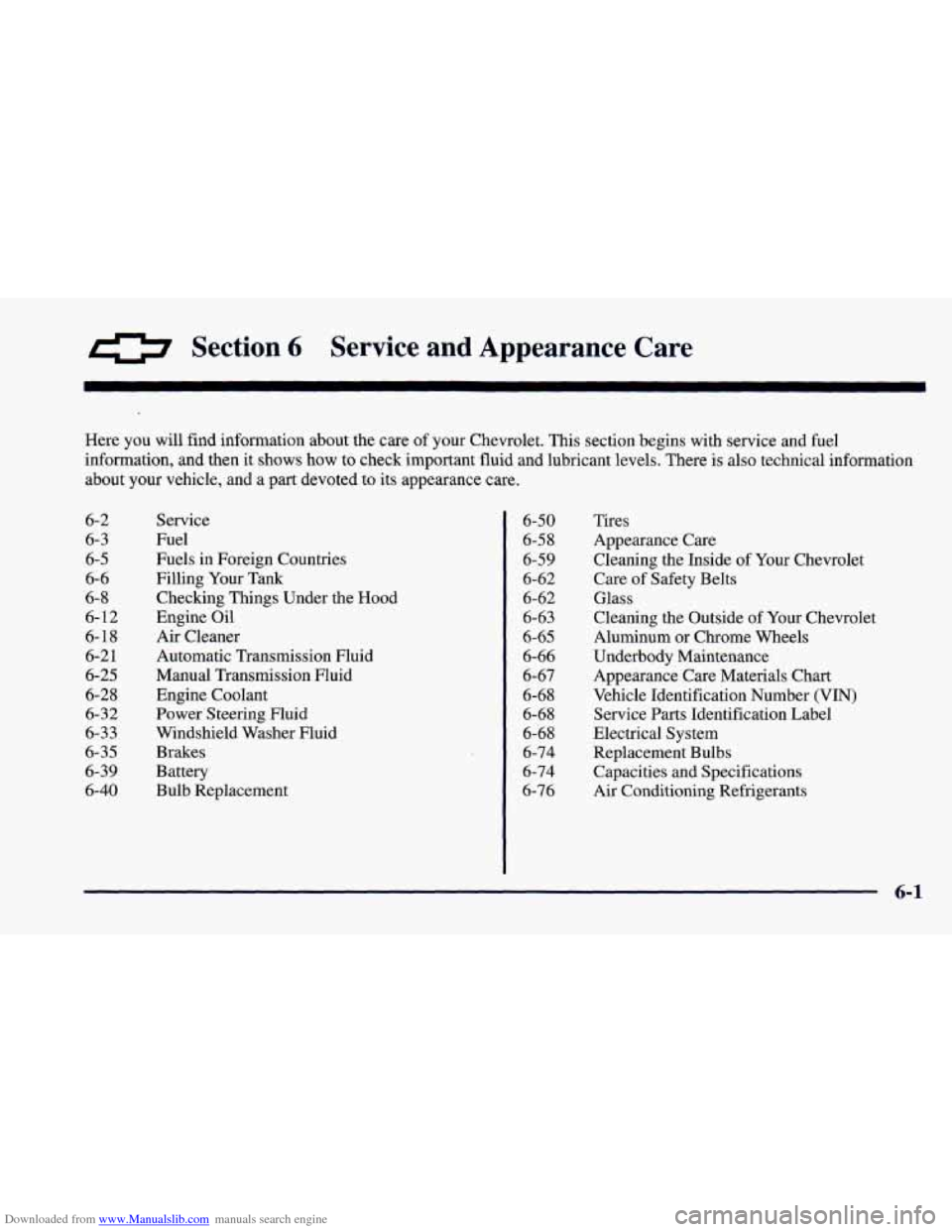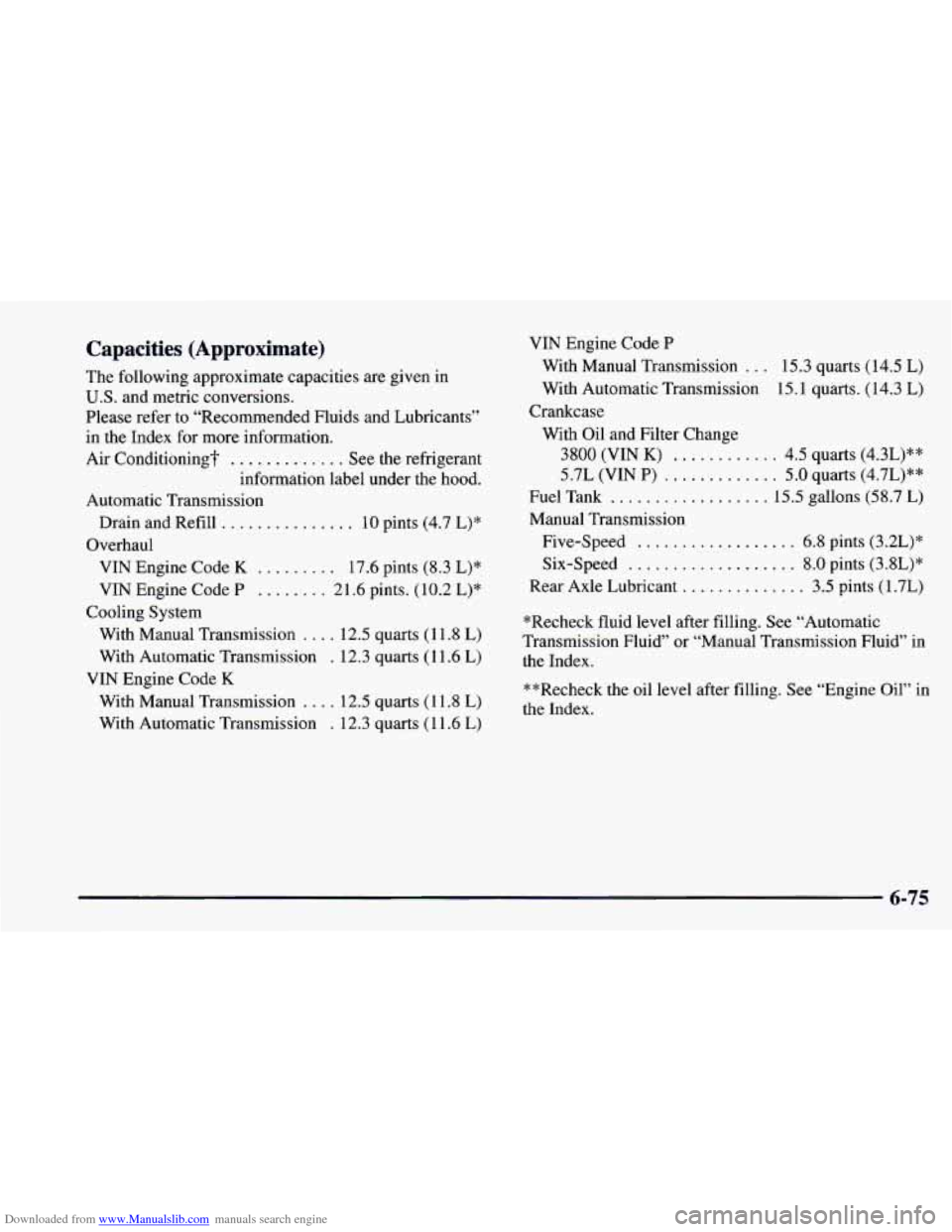1997 CHEVROLET CAMARO air conditioning
[x] Cancel search: air conditioningPage 129 of 404

Downloaded from www.Manualslib.com manuals search engine Voltmeter
You can read battery
voltage on your voltmeter.
If it reads less than 11 volts
or more than 16 volts while
your engine is running, and
it stays there, you may have
a problem with the
electrical charging system.
Have it checked right away. Driving with the voltmeter
reading in
a warning zone could drain your battery.
If you idle your engine for a while, the voltmeter reading
might move into the low voltage zone (indicated by red dots).
If the reading stays in the low voltage zone while you are
driving, you may have a problem with the electrical charging
system. Have it checked. While
the voltmeter reads in the
low voltage zone, your battery may not be able to power
certain electrical accessories, like
ABS. (If this happens,
your
ABS INOP light will come on. See “Anti-Lock
Brake System Warning Light” in
this section.)
If you must drive a short distance with the voltmeter
reading in a warning zone, turn
off all your accessories,
including your air conditioning system and audio system.
Brake System Warning Light
Your Chevrolet’s hydraulic brake system is divided into
two parts. If
one part isn’t working, the other part can
still work and stop you. For good braking, though, you
need both parts working well.
If the warning light comes on, there could be a brake
problem or the brake fluid level could be low. Have your
brake system inspected right away.
BRAKE
This light should come on
briefly when you turn the
ignition key to
RUN. If it
doesn’t come on then,
have it fixed
so it will be
ready to warn you if
there’s a problem.
If the light comes on while you are driving, pull
off the
road and stop carefully. You may notice that the pedal
is
harder to push. Or, the pedal may go closer to the floor.
It may take longer to stop. If the light is still on, or if the
anti-lock brake system warning light is flashing, have the
vehicle towed for service. (See “Anti-Lock Brake System
Warning Light” and “Towing Your Vehicle” in the Index.)\
2-79
Page 141 of 404

Downloaded from www.Manualslib.com manuals search engine Section 3 Comfort Controls and Audio Systems
In this section, you’ll find out how to operate the comfort control and audio systems offered with your Chevrolet.
Be sure
to read about the particular systems supplied with your vehicle.
3-2 3-3
3-3
3-4
3-4
3 -5
3-5
3-6 3-6
3
-6
Comfort Controls Air Conditioning
Cooling
Heating
Ventilation System
Defogging and Defrosting
Rear Window Defogger
Audio Systems
Setting the Clock for Systems without
Automatic Tone Control
Setting the Clock for Systems with Automatic
Tone Control 3-9
3-16
3-20
3-22
3-22
3-23
3-24 3-24
3-6
AM-FM
Stereo with Cassette Tape Player
AM-FM Stereo with Cassette Tape Player and
Automatic
Tone Control
AM-FM Stereo with Compact Disc Player and
Automatic Tone Control
Theft-Deterrent Feature Understanding Radio Reception
Tips About Your Audio System
Care of Your Cassette Tape Player
Care
of Your Compact Discs
Fixed Mast Antenna
3-1
Page 142 of 404

Downloaded from www.Manualslib.com manuals search engine Comfort Controls Temperature Control Knob
\@
With this system, you can control the heating and
ventilation in your Chevrolet. If you have the air
conditioning option, you can also control cooling.
Your vehicle also has the flow-through ventilation
system described later in this section.
Fan Control Knob
* FAN: Turn this knob to select the force of air
you want. Turn the knob
to change the temperature
of the air
flowing from the heating system. Turn it toward the
red or clockwise for warmer air and toward the blue or
counterclockwise for cooler air. The temperature
of the
air cannot be less than the temperature
of the outside air.
Air Control Knob
OFF:
The system is off.
2 VENT: Air flows through the upper air vents.
12 BI-LEVEL: Air is directed through the upper air
vents and the heater ducts.
'!! HEATER: This setting directs most of the air
through the heater ducts and some of the air through the
windshield defroster vents.
9 BLEND: Air is directed through the windshield
defroster vents and the heater ducts.
DEFROST: This setting directs most of the air
through the windshield defroster vents and some
of the
air through the heater ducts.
3-2
Page 143 of 404

Downloaded from www.Manualslib.com manuals search engine Air Conditioning (If Equipped)
I
The air conditioning system uses the same controls as
the heating system, except that the air control knob has
two extra settings, described below.
MAX: Provides maximum cooling or quick cool-down
on very hot days. This setting recirculates most of the air
inside your vehicle. If it is used for long periods of time,
the air may become
dry. This setting directs air through
the upper air vents.
A/C: Use for normal cooling on hot days. This setting
cools outside air and directs it through the upper air vents.
The air conditioner compressor operates in
MAX, A/C,
BI-LEVEL, BLEND and DEFROST when the outside
temperature is above freezing. When the air conditioner
is
on, you may sometimes notice slight changes in your
vehicle’s engine speed and power. This is normal,
because the compressor uses power and the system is
designed
to cycle the compressor on and off to keep the
desired cooling and help fuel economy.
Cooling
The air conditioner works best if you keep your
windows closed. On very hot days, open the windows
just long enough for the hot air
to escape.
1. Turn the air control knob to A/C for normal cooling.
For faster cooling move the knob to
MAX.
2. Turn the temperature control knob to a
comfortable setting.
3. Turn the fan control knob to the desired speed.
3-3
Page 247 of 404

Downloaded from www.Manualslib.com manuals search engine 0 Section 6 Service and Appearance Care
Here you will find information about the care of your Chevrolet. This section begins with service and fuel
information, and then it shows how to check important fluid and lubricant levels. There is also technical information
about
your vehicle, and a part devoted to its appearance care.
6- 2
6-3'
6-5
6-6
6-8
6- 12
6-18
6-2
1
6-25 6-28
6-32
6-33
6-35
6-39
6-40 Service
Fuel
Fuels
in Foreign Countries
Filling Your Tank
Checking Things Under
the Hood
Engine Oil
Air Cleaner Automatic Transmission Fluid
Manual Transmission Fluid
Engine Coolant
Power Steering Fluid
Windshield Washer Fluid
Brakes
Battery
Bulb Replacement
6-50
6-58
6-59
6-62
6-62
6-63
6-65
6-66
6-67
6-68
6-68 6-68
6-74
6-74
6-76 Tires
Appearance Care
Cleaning the Inside of Your Chevrolet
Care of Safety Belts
Glass
Cleaning the Outside of Your Chevrolet
Aluminum or Chrome Wheels
Underbody Maintenance
Appearance Care Materials Chart
Vehicle Identification Number (VIN)
Service
Parts Identification Label
Electrical System
Replacement Bulbs
Capacities and Specifications
Air Conditioning Refrigerants
Page 319 of 404

Downloaded from www.Manualslib.com manuals search engine Fuse
HORN
INJECTOR
ENG SEN IGNITION
A/C-CRUISE
Usage
Horn Relay
Fuel Injectors
Mass Air Flow, Heated Oxygen
Sensor, Reverse Lockout
Solenoid, Skip Shift Solenoid,
Automatic Transmission,
Brake Switch
V6 VIN K: Electronic Ignition
Control Module
V8 VIN P: Ignition Coil Module,
Crankshaft Position Sensor
Air Conditioning Compressor
Relay; Cruise Control Switches
and Module
Relay
B
C
D
E
F
G
H
J
Usage
Air Conditioning Compressor
Anti-Lock Brake
Systeflraction Control
System (ASR)
Cooling Fan
1
AIR Pump
Cooling Fan
2
Not Used
Fog Lamps
Cooling Fan
3
6-73
Page 321 of 404

Downloaded from www.Manualslib.com manuals search engine Capacities (Approximate)
The following approximate capacities are given in
U.S. and metric conversions.
Please refer to “Recommended Fluids and Lubricants”
in the Index for more information.
Air Conditioning?
............. See the refrigerant
information label under the hood.
Automatic Transmission
Drain and Refill
............... 10 pints (4.7 L)*
Overhaul VIN Engine Code
K ......... 17.6 pints (8.3 L)*
VIN Engine Code P ........ 21.6 pints. (10.2 L)*
With Manual Transmission
.... 12.5 quarts (1 1.8 L)
With Automatic Transmission
. 12.3 quarts (1 1.6 L)
With Manual Transmission
.... 12.5 quarts (1 1.8 L)
With Automatic Transmission
. 12.3 quarts (1 1.6 L)
Cooling System
VIN Engine Code
K
VIN Engine Code P
With Manual Transmission
... 15.3 quarts (14.5 L)
With Automatic Transmission 15.1 quarts. (14.3 L)
With Oil and Filter Change
Crankcase
3800 (VIN K) ............ 4.5
quarts (4.3L)**
5.7L (VIN
P) ............. 5.0 quarts (4.7L)**
Fuel Tank .................. 15.5 gallons (58.7 L)
Manual Transmission
Five-Speed
.................. 6.8 pints (3.2L)*
Six-Speed
................... 8.0 pints (3.8L)*
Rear Axle Lubricant
.............. 3.5 pints (1.7L)
*Recheck fluid level after filling. See “Automatic
Transmission Fluid” or “Manual Transmission Fluid” in
the Index.
**Recheck the oil level after filling. See “Engine
Oil” in
the Index.
6-75
Page 322 of 404

Downloaded from www.Manualslib.com manuals search engine Vehicle Dimensions
Length .................. 193.2 inches (49 1 cm)
Width
.................... 74.1 inches (1 89 cm)
Height Wheelbase
.............. 101.1 inches (257 cm)
Front Tread
.............. 60.7 inches (154 cm)
Replacement Parts
Air Cleaner Filter ...................... A1 163C
Battery
................................ 75-60
Engine Oil Filter VIN Engine Code
K .................... PF47
VIN Engine Code P
.................... PF25
Fuel Filter
............................. GF578
PCV Valve VIN Engine Code
K ................. CV892C
VIN Engine Code P
................. CV895C
Radiator Cap
........................... RC24
Spark Plug
VIN Engine Code
K ....... -41-921 (0.060' Gap)
VIN Engine Code P ....... -41-943 (0.050' Gap)
Air Conditioning Refrigerants
Not all air conditioning refrigerants are the same.
If the air conditioning system in
your vehicle needs
refrigerant, be sure the proper refrigerant is used.
If you're not sure, ask your Chevrolet dealer.
6-76